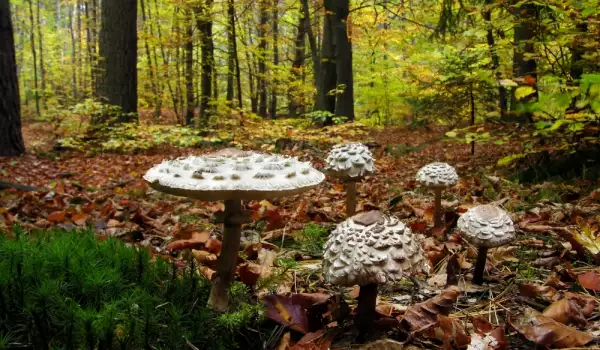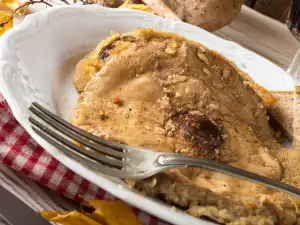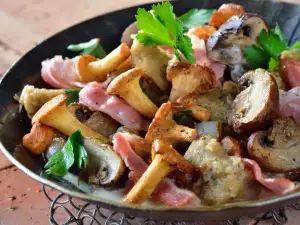The parasol mushroom /Macrolepiota procera/ is a type of basidiomycete that originates from the genus Macrolepiota. The parasol mushroom is found very often under the names Snakeskin Parasol, Snakes Hat, Drumstick Mushroom. Parasol mushroom is very common. The main quality for which this mushroom is collected is its exceptional taste.
The cap of the parasol mushroom is ovoid and does not expand until the stem is fully extended. Then its volume begins to gradually increase. As the cap develops and slowly expands, it tears the partial cover beneath its hairs, resulting in a ring around the stem.
The fully developed parasol mushroom cap is flat and under favorable conditions and humidity reaches a huge diameter. Concentric circles of brown scales are observed on it, which are located on a white, cream or pale brownish background.
In the center of the cap there is a bump, which is always covered with the same brown material from which the scales around it are made. The edge of the cap is not folded, but studded with hanging pieces that give it a jagged shape.
The stump of the parasol mushroom reaches a height of up to 40 cm and develops before the cap. At first its interior is dense and white, but later it becomes hollow and with strong fibers. On the surface of the stump there are scales that resemble snake skin. The base of the stump is pear-shaped.
The meat of the parasol mushroom is soft but not falling apart. It has a white color, but when injured, it turns a light pink color. It has a nice nutty aroma, mostly of hazelnuts, which is most noticeable in the older mushrooms.

The gills on the mushroom are white, sometimes have pink patterns and are located very close to each other. They are not fused to the stump and break easily. The spores pollen is white.
Collection and storage of parasol mushroom
Parasol mushroom grows mainly in forest meadows and open mountain pastures. In many cases, you can also find it in forests, thickets and bushes. This mushroom does not like moisture very much and grows in dry weather, just when other mushrooms reduce their fruiting. You can harvest parasol mushroom from early spring to late fall. The parasol mushroom, like other mushrooms, is highly intolerant to soils that have been treated with chemicals and artificial fertilizers.
Parasol mushroom is a highly prized mushroom. The cap is cut off and the stump is removed because it is tough and fibrous and therefore not very tasty. The tastiest are the young, barely expanded caps.
Parasol mushroom can easily be mistaken for the closely related shaggy parasol, but the latter is much smaller and its meat is reddish.
Parasol mushroom in cooking

Parasol mushrooms should be cooked immediately after collection or purchase. As mentioned, only the cap is used for culinary purposes because the stump is fibrous and stringy and not edible. The mushroom is cut into pieces and cooked, most suitable to be breaded, used as a filling for filo pastry pies or canned. Parasol mushroom is not suitable for drying.
Parasol mushrooms can be fried in butter, added to rice, combined with other vegetables or meats. They are most delicious breaded. For this purpose, the cut pieces of parasol mushroom are dipped alternately in flour and then in egg. They are fried in hot oil and eaten warm. The easiest way to prepare parasol mushrooms is to fry them washed and salted on the stove with a little butter.
Parasol mushroom benefits
The parasol mushroom is one of the tastiest edible mushrooms. Like most mushrooms, it is useful for the body and provides valuable vitamins and minerals. The qualities of the parasol mushroom are indisputable and apart from being considered a giant among mushrooms, it is a desirable dish on most tables.
Health risks from parasol mushrooms
Both the benefits of mushroom consumption and serious health risks go hand in hand. When collecting parasol mushrooms, you must be careful not to confuse it with one of the poisonous fly agarics. In some cases, the newly emerged parasol mushrooms resemble other types of mushrooms, so it is recommended that the mushroom grows to make it easier to recognize. In North America, the most common poisonous twin of the parasol mushroom is Chlorophyllum molybdites, the mushroom that causes many poisonings.



















Comments